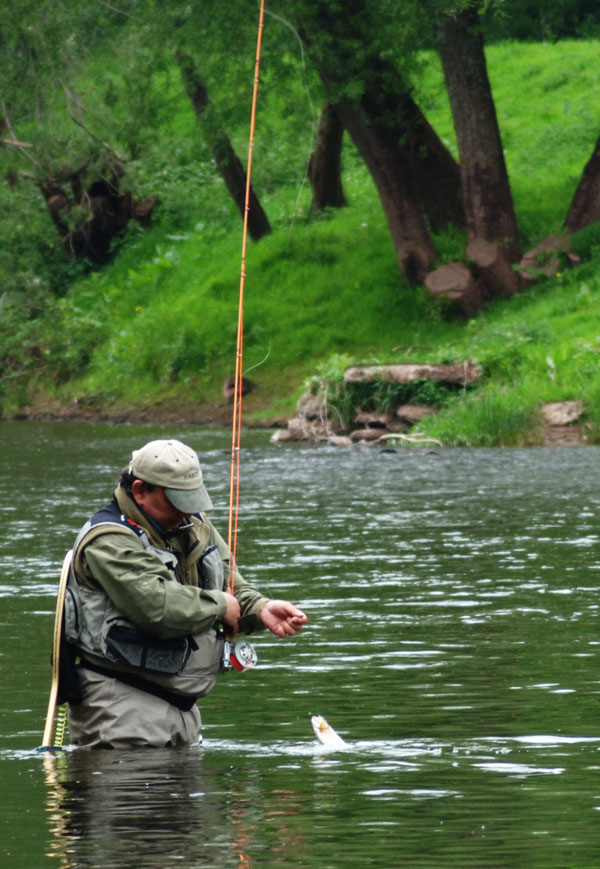
Eyes Wide Open – Trout Fishing Techniques
In May this year, a friend Gwilym Hughes from North Wales came to visit and, as an avid game fly fisher, I asked him if he would like to enjoy a day on the River Usk.
Gwilym accepted the offer immediately. I should point out to those that do not recognize the name that Gwilym is a qualified A.P.G.A.I coach in single-handed, double-handed fishing and fly tying. He has represented his country in the world championship river competition and has coached the Welsh ladies team. Without a doubt, I could fill the rest of this page with his achievements but to honest, I think that would still be an understatement to his natural fishing abilities.
The aim of the day was for Gwilym to fish a short 100 hundred yards of the Ty Mawr beat that the majority walk past and see what methods would result in fish in the hand. The conditions were by no means perfect in that the barometric pressure had dropped and the air temperature was fluctuating all day from warm to bitter cold with intermittent rain showers.
The stretch that was chosen was 5 meters upstream from the new steps to above the area of the two groynes.
The initial set up that Gwilym chose was a Hardy Angel rod and reel weighted #5 with a tapered leader of some 12′ down to 3lb breaking strain point. The leader was fluorocarbon which was explained used in all of Gwilym’s fishing. The line was a weight-forward. It was explained that if the real delicate presentation was required then consideration would be given to using a double tapered line.
Before choosing a fly the river was checked for relevant fish movement and any indication as to what the trout were feeding on. A few olives were seen floating down and Gwilym chose the pattern which is detailed in another article on this site. The Gwilym’s Olive.
I was immediately impressed as to the way he prepared all his tackle. Gwilym was meticulous in the tying of his knots and with using fullers earth to decrease the line. Something he did throughout the day.
The approach was made toward the first rising trout. This approach was slow and deliberate. On reaching the point he was to cast from the first of all watched the way the current flowed explaining that he was watching to see how it may affect the travel of the fly towards the rising fish.
So many anglers make the error of jumping in and storming off after the first fish they see a rise. Common sense requires you to wait and see how many fish are moving freely and you would be amazed at how many fish are in between where you step into the water and where you need to be to cast to the first fish seen.
After a few minutes, another two good fish rose to prove the point, below where the first had been seen. A plan of approach and attack was planned by Gwilym which would have impressed a military planner. I was reminded of the story of the old bull and young bull and this was a classic. If he had rushed in he would have lost the opportunity of catching the bigger fish where now he set out to catch them all.
A first delicate cast was made which was short of the target. This was deliberate so as to measure the exact distance that the cast needs to cover the fish properly. Throughout the day emphasis was put on presentation. “If that’s wrong then it doesn’t matter what fly you are using.
With that in mind, Gwilym used a reach cast which effectively allows a longer drift of the artificial fly without drag. The fly moved over to where the target fish was and an almost imperceptible amount of drag was seen in the fly as it passed over where the fish was lying.
The second cast was made again a reach cast but this time with an added mend making the cast a reach mend cast. This immediately allowed for another yard of drag-free drift of the artificial fly. As the fly went over the lie there was a small dimple of a rise in the water. The fly line was lifted and a fish was on.
This fish was played quickly and after an inspection was returned unharmed as were all the fish caught throughout the day.
The other two fish that were close by continued to rise but ignored the flies that Gwilym presented. He was convinced that they were feeding on something very small such as aphids or mini-sized midge.
What I witnessed then was a clinical attempt to work out exactly what was happening with the water being sieved for clues and even an examination of the bushes and trees that were on our side of the bank.
to test what was in the surface of the water Gwilym pulled from his fly vest a piece of net curtain which was elasticated around the edges which fitted over his net. The netting was then held with only a couple of inches in the water to see what was floating in the surface layer of the river. So simple yet so effective. Those of you that are from North Wales will recognise where Gwilym lives as his house is the one with squares cut into the upstairs curtain nets.
I mentioned earlier that the day was a hard one and these two fish could not be tempted. the fly life dropped away and Gwilym changed tactics. Having presented the dry fly Upstream he then started at the same point again. He showed me that he was now going to fish a system of an upstream dry fly with a nymph suspended from the hook bend of the dry fly. I have heard of this system being used a great deal in New Zealand and was looking forward to witnessing someone use it competently.
The dry fly was changed to a size 14 Klinkhamer type fly and a length of line was attached to the hook bend by use of a blood knot. the length of the line from dry fly to point nymph was dictated by the depth of water that you intended to fish and by the flow of the current. You have to be prepared to experiment with this method to get to the right depth with the nymph because when you do the trout take the fly freely.
The advantage of the dry fly is two-fold in that the fish will still take the dry and are easily hooked as the line to the point fly does not impede the fish from being hooked and secondly, the dry fly acts as an indicator as to when the nymph may have been taken. I say may as you need to lift or strike each time the dry goes under the surface which may be often when the nymph touches bottom.
In the photograph above you can see Gwilym fishing this method and took fish from where no one normally fishes and good fish at that. Notice how shallow the water is that he is fishing. The question of stealth and good presentation of the flies is apparent again.
Two steps later and another good fish was on. The third method that resulted in fish was simply fishing the dry fly downstream. Simply perhaps is understating it as the fly is still fished without drag. The fly is cast across and slightly upstream and the fly is followed around by the rod tip so extending the drag-free drift. This method requires constant casting and you are effectively covering all the water quickly and efficiently.
Gwilym fished this method over the same piece of water that he had just fished twice with the upstream dry and then again with upstream dry and hanging nymph (New Zealand style). I didn’t really expect to see him catch much by this method. How wrong was I as another two fish came to this method in a short space of time? It is again all about presentation and although to our eyes, they look similar to the trout the tiny difference in approach allows the artificial to truly represent the real insect.
The whole day was a revelation to me in that it gave me confidence that fish could be taken in any conditions within reason. To put it in perspective a number of our members were fishing on the same day. The ones I spoke to are all competent anglers with the fly and have been relatively successful. They caught nothing all day. Gwilym om the other hand landed 7 and played and lost many more. More to the point he got fish interested and moved them to his flies.
The idea is all about correct presentation. Here is a photo of the view of Gwilym’s line fishing the New Zealand style upstream technique. You can see through the rain that there is no pressure or drag on the flies.
I asked Gwilym if I could show a series of photographs of his flies in his box to which he agreed. The following sequence is of all his river flies for both trout and grayling. The sizes are a lot smaller than most of us use. If nothing else perhaps there is a lesson in that for us all.
Czech Nymphs
Polish Nymphs
Dry Sedge Patterns
Emerging Dry Patterns
Spinners and Duns
Reed Smuts and Midge Larva (Size 26’s)
Weighted Nymphs
I have spoken much about presentation in this article and subsequently, I have decided to show you the sequence of photographs showing how Gwilym casts his flies allowing the dry flies to lose any water and to ensure that the flies remain on the water where the trout can get at them. Remember every false cast can scare a fish and more importantly if the fly is off the water the trout cannot get at it.
The line is first rolled to the surface using a roll cast. Remember this is a sequence of photos where the New Zealand method of fishing has been used i.e. a weighted nymph with a dry fly indicator. You can clearly see the fly being brought to the surface from the depths.
The rod tip then moves backwards in the power stroke as the weight of the line is in a position to load the rod effectively.
The rod tip is stopped abruptly at the top of the cast and allows the transfer of energy from the loaded rod back to the line so that during the pause the line travels behind the rod in preparation for the forward power stroke or cast.
The photograph below shows the rod tip moving forward reloading the rod with the weight of the line allowing the rod to compress efficiently.
If you look at the photograph below the power stroke is stopped again allowing the transfer of energy from the rod tip to the line giving it the energy to unfurl in front of the rod tip.
Due to the adverse wind conditions, the rod tip is bought lower so as to change the plane or angle of the cast to develop a more efficient tighter loop to cut through the wind which counteracts the wind from pushing the line back and subsequently collapsing the cast. In conditions where the wind is minimal this action would cause the cast to collapse as the wind resistance is effectively holding the cast up in the air.
The loop continues to unfold and presents a nice line on the water.
A nice tight loop showing good efficient rod control.
It was a great privilege to spend the day with Gwilym on the water and to enjoy his company and learn from his vast knowledge. To be honest I believe that all we did was scratch the surface. I appreciate the advice and information that he gave me and in allowing me to pass it on to you.
It is hoped that during the winter he may well visit the Tying Class at Pontiac Village Hall where he will be able to explain further his fishing strategy and pass on some of his knowledge and skills.
If you are interested in improving your single or double-handed casting then come and join us at the casting clinic at Ty Mawr held each Monday between 6.30 pm to 8.30 pm between June and August.






































